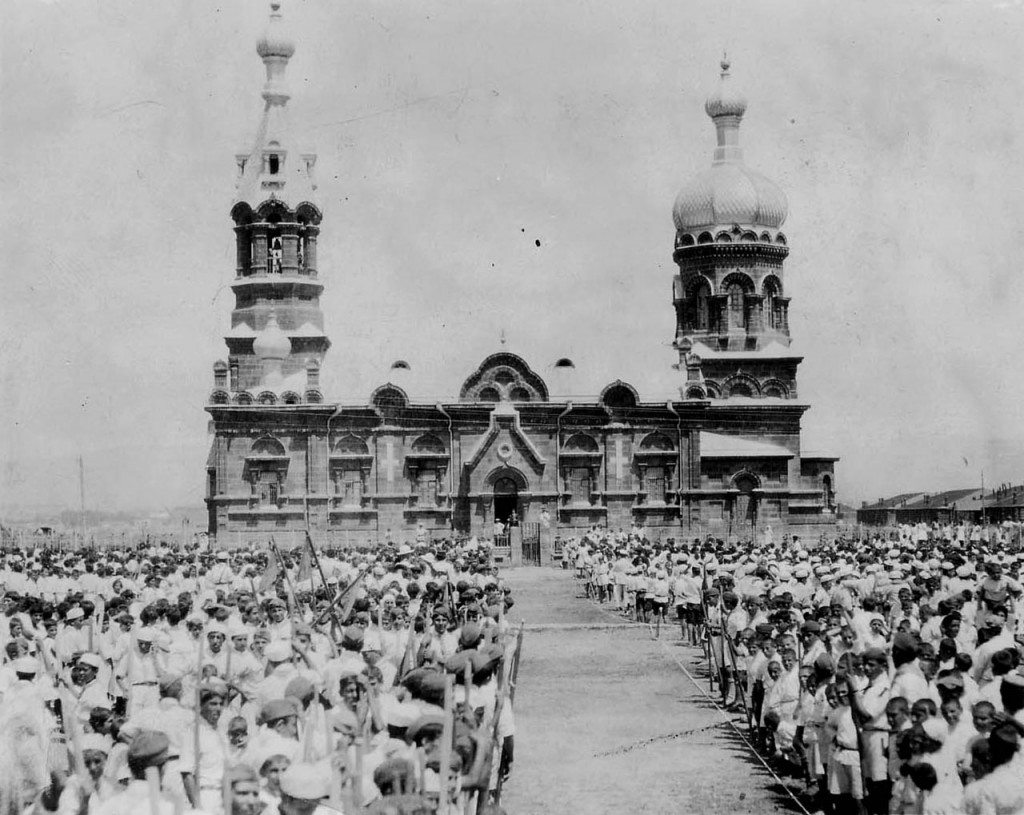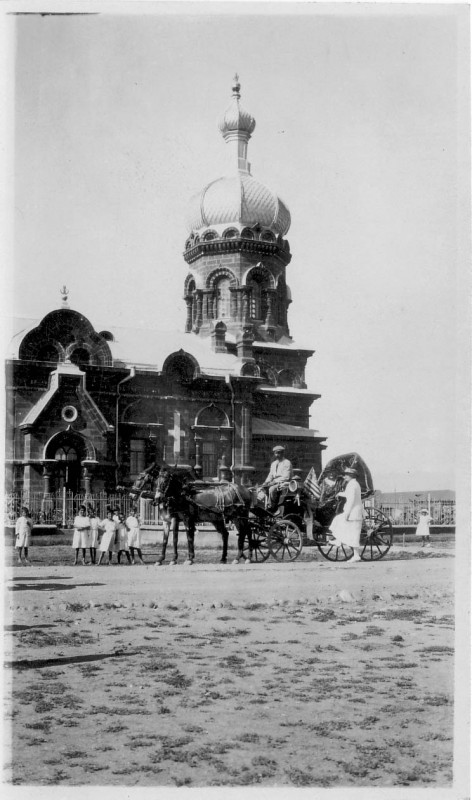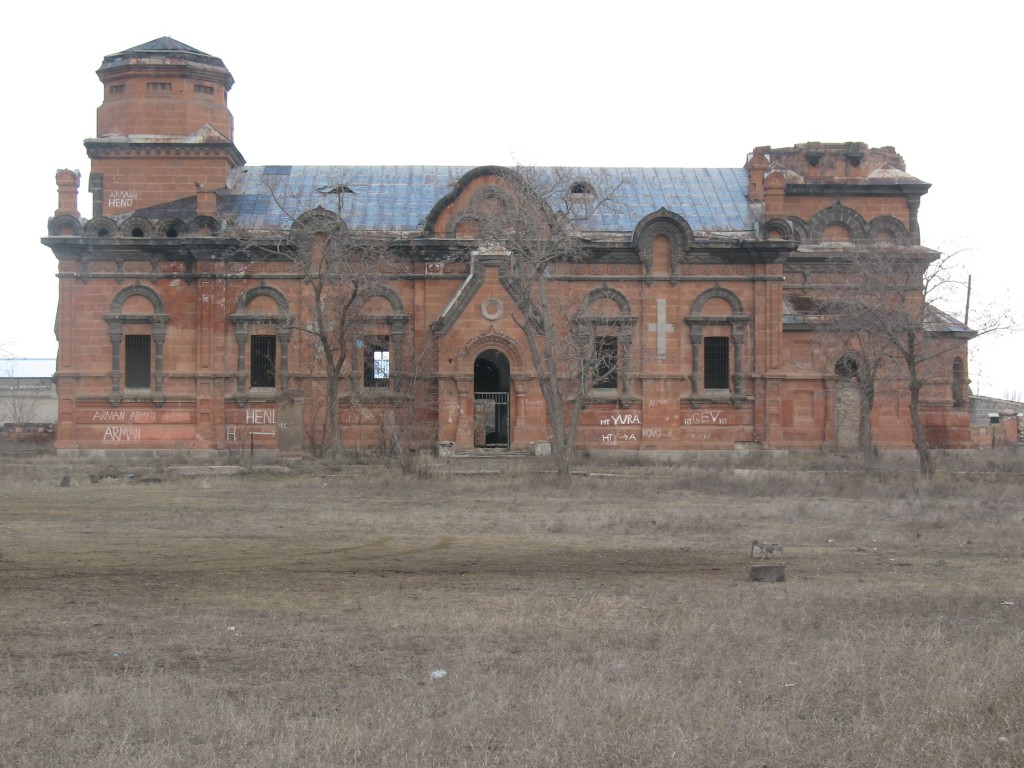Restoring Faith in the New Armenia: Kazachi Post Church
The church at Kazachi Post appears in many Near East Relief photographs. How did a Russian Church become a new cradle of Armenian Christianity?

A Church Among the Barracks
The church at Kazachi Post was elaborate, elegant, and unmistakably Russian in appearance. Yet a visitor entering the church in the early 1920s would have been astonished by its contents. The visitor would see a priest performing the badarak, or Armenian Apostolic Divine Liturgy, in a nation where religion was forbidden. He would find himself immersed in centuries-old Armenian hymns. But nothing would surprise the visitor so much as the congregation: hundreds upon hundreds of Armenian children in prayer, all wearing the same simple uniforms.
How did a Russian church become a new cradle of the Armenian Apostolic faith?
In 1837, Tsar Nicholas I of Russia arrived in the Transcaucasian town of Gyumri. He promptly renamed the town Alexandropol in honor of his wife, Alexandra Feodorovna, and directed the construction of a major military base a few miles away. The barracks at Kazachi, Polygon, and Seversky Posts housed thousands of soldiers from the Russian Imperial Army. The sprawling base became a strategic location in the Russo-Turkish War in the 1870s.
Russian Orthodox Christianity was the official state religion of the Russian Empire, with the Tsar as the head of the Church. Naturally, the army base near Alexandropol included a church. St. Arsenije Church was consecrated in 1910. The church was named for a St. Arsenije Sremac (also called St. Arsenius), a Serbian Orthodox archbishop from the 13th century.
The church combined local architectural elements with traditional Russian design. The structure was built in the Russian ecclesiastical style with a focus on natural light. The interior was probably lavishly decorated with murals and icons. The east side of the church featured a traditional Russian “onion dome.” A tall, conical bell tower typical of Transcaucasian churches reached for the heavens on the western side. The bell tower was flanked by two small onion domes and topped with a third dome. Russian Orthodox crosses, which include two horizontal crossbeams and a slanted crossbeam at the bottom, topped each dome and the doorways.

Boys from the Near East Relief orphanage complex at Alexandropol gather outside of Kazachi Post Church, c. 1922. Note that the Russian Orthodox crosses have been removed from the domes and doorways.

20,000 New Parishioners
By the time Near East Relief opened its enormous orphanage at Kazachi Post, the military complex had been vacant for several years. It is unclear if the church had been used during that time. The other buildings were in a severe state of disrepair. Near East Relief workers and local staff refurbished the barracks to make them fit for habitation by thousands of children.
St. Arsenije Church found new life as well. Now known simply as “Kazachi Post Church,” it served as the house of worship for the new orphanage complex. With the influx of children and adult relief workers, the church became a bustling community. The 1921 Near East Relief Annual Report states that “on Sunday morning the [Kazachi Post] church is filled with nearly 2,000 children and employees and our local personnel.” It is worth noting that 2,000 children was only 10% of the orphanage population!
The services followed the Armenian Apostolic tradition, and included Armenian music sung by a children’s choir with more than thirty voices. Near East Relief employed two Armenian Apostolic priests: one was in charge of Sunday services; the other taught lessons and attended to religious duties at the orphanage hospitals. On occasion, the Bishop of Alexandropol preached at the church.
Armenia became a Socialist Republic in 1920 after invasion by both the Turkish Nationalist and Bolshevist armies. The Republic was incorporated into the Soviet Union in 1922. The USSR was officially opposed to religion. In fact, religious figures could be prosecuted. The Soviet government banned formal religious instruction in Near East Relief orphanages in the Caucasus region. However, the orphans and staff were permitted to continue worshiping at Kazachi Post Church. Near East Relief was allowed to continue employing Armenian Apostolic clergy.
A group of girls from Kazachi Post orphanage, c. 1922. The church dome and bell tower are visible in the background, allowing us to identify the location of this photograph.
The Faith of Their Fathers
Near East Relief was a nonsectarian humanitarian organization with strong Christian roots. However, it was not a missionary organization. Near East Relief leadership often referred to the Christians of Asia Minor as “indigenous Christians” based on their proximity to the Holy Land. The orphanages did not follow a uniform religious education program. All Near East Relief orphanages offered a Christian education with an emphasis on core values such as hard work, thriftiness, and charity. Generally, the religious instruction followed the curriculum that would have been offered in local schools. Every effort was made to educate the children in the faith of their lost parents.
While the Near East Relief religious education classes in Greek and Syria were generally Protestant in nature, the children of Alexandropol followed the Armenian Apostolic faith. Armenia’s Christian roots date back to the early 4th century, when Armenia became the first country to adopt Christianity as its official religion. The Armenian Apostolic Church traces its lineage to the apostles Thaddeus and Bartholomew. Armenian liturgy is distinct from other branches of Christianity. The Armenian Apostolic Church is governed by the Catholicos from the holy city of Etchmiadzin. Kazachi Post was located a mere 70 miles from the Etchmiadzin Cathedral, the mother church of the Armenian Apostolic faith.
When the children of Kazachi Post Church left Alexandropol to start new lives in new cities and countries, they took their Armenian Apostolic faith with them. There are thriving Armenian Apostolic communities in Europe, North and South America, and South Asia. Lebanon has had a strong Armenian Apostolic tradition since the first Armenian Genocide survivors settled there. Before the Syrian Civil War began, there were numerous active Armenian churches in Syria. The vast majority of Syrian Christians have fled the country, with many ethnic Armenians seeking asylum in Armenia.

Orphan girls bowing before a priest in front of Kazachi Post Church, c. 1922.
A Damaged Icon
Sadly, Armenia was rocked by a massive earthquake in 1988. Leninakan (formerly Alexandropol, now Gyumri) was devastated. The Kazachi Post Church, already in disrepair, was all but destroyed. The dome and bell tower collapsed and the roof was damaged. The building was no longer safe for use, and the empty church was decommissioned.
The building is now a shell. The elegant windows that filled the chapels with celestial light are long gone. The external walls are covered in graffiti. Today, the ruins of Kazachi Post Church stand as a testament to the power of nature.
There is no trace of the 20,000 orphans that once learned the faith of their lost families within the church’s walls. Perhaps if we listen closely, we can hear the echoes of their young voices raised in song.

Photograph by Shant Mardirossian
